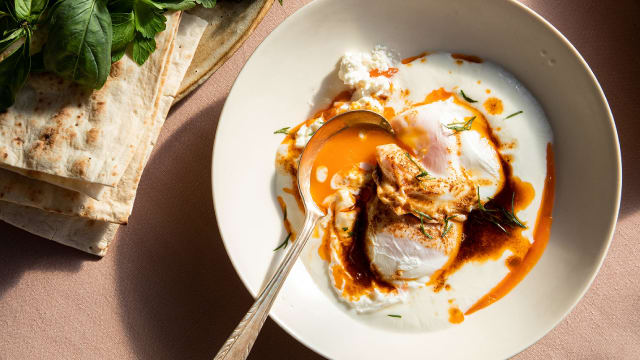Kitchen Scent

It never fails to thrill me — the moment when the paprika hits the sizzling butter. The sweet, earthy scent takes me from my small kitchen in Brussels back to the Panagyurishte region of Bulgaria — a small valley east of Sofia surrounded by mountains. As a trained perfumer, I live following my nose, and in the kitchen, it’s my main guide.
The pleasure we derive from aromas is considerable. Our sense of smell is part of the limbic system and is directly connected to the parts of the brain that process emotions and memories. When we experience scents during cooking, we have a chance to heighten mindfulness, because as one sense is stimulated, all others are activated too. It’s no wonder the excitement starts before I even taste anything. The alchemy that happens among ingredients, making aromas more vivid and intense, satisfies not just my hunger but my sense of adventure.
Scent of an Egg
The first time I had the dish was during a trip on a quest for the famous roses of Bulgaria. The country is among the largest producers of rose essence in the world, and what I didn’t anticipate was that a simple egg preparation would make me return for food alone.
Panagyur eggs, or yaitsa po panagurski, as they’re called in Bulgarian, take their name from the southern town of Panagyurishte. I still remember how intrigued I was when a waiter at a local restaurant placed Panagyur eggs in front of me. The bowl was filled with a fluffy cream. Crimson, Pollock-like splashes shimmered against the pure white background. As I plunged my spoon into the sauce, I discovered poached eggs with runny yolks. The topping of garlicky yogurt and crumbled cheese was garnished with a paprika-infused butter.
The fragrance of the dish was so heady that I sat for a few moments with my spoon mid-air. The caramelized warmth of butter mixed with the fruity sweetness of paprika and the milky tang of yogurt. The soft eggs and creamy sauce were punctuated by the salty cheese. Panagyur eggs became one of my favorite dishes to eat in Bulgaria and to make at home.
Since the dish relies on basic, wholesome ingredients and takes minutes to put together, it’s not surprising that it’s popular in Bulgaria, and under different guises, in the whole Balkan region. The Turkish çılbır and variations from Macedonia, Serbia, Montenegro, and Bosnia-Herzegovina that are called chalbur or čimbur feature a similar idea of fried or poached eggs in a sauce. Yogurt may or may not be included, but paprika retains its leading role.
Bulgarian Wholesomeness
I usually make Panagyur eggs the way I learned in Bulgaria, with feta and yogurt in the sauce. So important is yogurt to the local cuisine that it’s called milk — sour milk, or kiselo mlyako in Bulgarian. Fresh milk is referred to as pryasno mlyako, to avoid confusion. The two bacterial strains that are required for Bulgarian kiselo mlyako (Lactobacillus delbrueckii ssp. bulgaricus and Streptococcus thermophilus) give it a distinctive sourness and a crisp flavor reminiscent of green apples. To replicate the same brightness in the final dish, I look for yogurt in the Balkan or Middle Eastern shops. Nevertheless, Panagyur eggs have such a complex flavor that any yogurt would do in a pinch.
The components of the dish can be arranged in different ways — with the eggs on top of yogurt or vice versa. In my recipe, I follow the suggestion by Ivan Zvezdev, a Bulgarian chef who runs a popular YouTube channel. Zvezdev recommends alternating the textures and layering feta, yogurt sauce, and eggs.
A flourish of paprika-perfumed butter is drizzled on top of the dish at the last minute for a full spectrum of aromas. Although the fruity and sweet Hungarian paprika gives the best approximation of the Bulgarian variety, I like to experiment with other types of chile peppers. Kashmiri chiles taste sweet and mild, with nuances of dried tomato and apricot. Smoked Spanish pimentón has hints of chocolate. When I crave heat, I add a dash — or several — of cayenne. Any way, the result is warm and seductive.
In my own twist, I serve Panagyur eggs with lavash and a plate of green herbs such as basil, mint, coriander, or dill. While this way of serving is not traditional, the aromatic herbs with their sharp, spicy scents add effervescence and brightness to the dish and cut through the milky richness of the sauce. A piece of flatbread rolled around a basil leaf and dipped into the tangy-spicy eggs makes for a memorable mouthful, with the anise-like sharpness of the herb making the yogurt taste even creamier.
Where I never waver is in remembering the advice I received from a Bulgarian grandmother — keep the egg-poaching liquid. With a few cubed vegetables such as onion, carrot, potato, and a garnish of parsley, it makes for a quick, refreshing soup.
RECIPE | Panagyur-Style Eggs with Paprika Butter
Key Takeaways
- Panagyur-style eggs is a protein-rich dish.
- Eggs are hearty and nutritious.
- Food and scent deepens memories.



